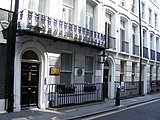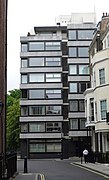St James's Place
Street in the City of Westminster, London, England

St James's Place is a street in the St James's district of London near Green Park.[1] It was first developed around 1694, the historian John Strype describing it in 1720 as a "good Street ... which receiveth a fresh Air out of the Park; the Houses are well-built, and inhabited by Gentry ..."[2][3] Henry Benjamin Wheatley wrote in 1870 that it was "one of the oddest built streets in London."[3]
Spencer House, which was commissioned by the 1st Earl Spencer in 1756, stands at number 27 and is now listed as Grade I.[4][5] A further thirteen properties are Grade II listed; Number 4 is Grade II* listed.[6]
Notable residents

- Joseph Addison (1672–1719), author and politician who founded The Spectator, lived here in 1710.[3]
- Eustace Budgell (1686–1737), English writer and politician.[3]
- Sir Francis Burdett (1770–1844), reforming politician known as "Old Glory", lived at number 25 from 1820 to 1844.[7]
- Sir Francis Chichester (1901–1972), pioneer aviator, sailor and author, lived at number 9 from 1944 to 1972.[8]
- Lord Randolph Henry Spencer-Churchill (1849–1895), British statesman, lived at number 29 from April 1880 to late 1882.[9]
- James Craggs the Younger (1686–1721), English politician.[3]
- Mary Delany (1700–1788), English artist and writer.[3]
- Captain Basil Hall (1788–1844), Scottish traveller and author, lived at number 4.[3]
- Cornelius Hatfield, Jr. (1755–1823), American Revolutionary War Loyalist partisan captain from Elizabeth, New Jersey.[10]
- John Hick (1815–1894), English industrialist, art collector and Conservative Party politician, lived at number 4.[11][12]
- Henry Grattan (1746–1820), Irish politician.[3]
- White Kennett (1660–1728), Bishop of Peterborough.[3]
- John Lubbock (1803–1865), English banker and scientist.[3]
- Stafford Northcote, 1st Earl of Iddesleigh (1818–1887), British statesman, lived at number 30.[citation needed]
- Richard Rigby (1722–1788), English civil servant and politician.[3]
- Samuel Rogers (1763–1855), 19th-century English poet.[13]
- Oscar Wilde (1854–1900), Irish playwright, novelist, essayist, and poet, rented rooms at 10–11 for five months in 1893–1894.[citation needed]
- John Wilkes (1725–1797), English journalist and politician, lived there in 1756.[3]
Gallery
-
 Blue Plaque at 4 St James's Place
Blue Plaque at 4 St James's Place -
 Francis Chichester Map and Guide publishing house at 9 St James's Place
Francis Chichester Map and Guide publishing house at 9 St James's Place -
 10-11 St James's Place
10-11 St James's Place -

See also
References
- ^ St James's Street, londontown.com, accessed 23 April 2012.
- ^ Stow, John. "Southwark, and Parts Adjacent", A Survey of the Cities of London and Westminster, Borough of Southwark and Parts Adjacent, p. 663.
- Also see "St James's Park," The Parish of St. James Westminster. Part II: north of Piccadilly, Volumes 31–32 of Survey volumes, Athlone Press, University of London, 1963, p. 511ff.
- ^ a b c d e f g h i j k l Wheatley, Henry Benjamin (1870), Round about Piccadilly and Pall Mall, Smith, Elder & Co., pp. 167–169
- ^ Ed Glinert (2004), "St. James's Place", The London Compendium, Penguin UK, ISBN 9780141012131
- ^ Historic England. "SPENCER HOUSE (1264952)". National Heritage List for England. Retrieved 24 April 2012.
- ^ "The National Heritage List for England (search term: st james's place sw1)". English Heritage. Retrieved 24 April 2012.
- ^ "Burdett, Sir Francis", The History of Parliament, accessed 24 April 2012.
- ^ "Francis Chichester green plaque in London". BluePlaquePlaces.co.uk. 17 September 1993. Retrieved 1 March 2017.
- ^ Buczacki, Stefan (2017). "Churchill Facts: Residences of Winston and Clementine Churchill". The International Churchill Society. Retrieved 27 February 2017.
29 St. James's Place (April 1880—late 1882). Leased by Lord Randolph Churchill.
- ^ "London, England, Land Tax Records, 1692–1932". Ancestry.
- ^ Royal Blue Book, Fashionable Directory and Parliamentary Guide. B. W. Gardiner, Princes Street, Cavendish Square. 1873. p. 744.
- ^ List of Members of the Institution of Civil Engineers. Ancestry.com, Civil Engineers Lists 1818–1930 Ancestry.com Operations Inc: Institution of Civil Engineers. 1886.
{{cite book}}: CS1 maint: location (link) - ^ Richard Ellis Roberts (1910), "St. James's Place", Samuel Rogers and his circle, Dutton, p. 48
External links
 Media related to St James's Place, London at Wikimedia Commons
Media related to St James's Place, London at Wikimedia Commons
51°30′20.61″N 0°8′22.78″W / 51.5057250°N 0.1396611°W / 51.5057250; -0.1396611
















